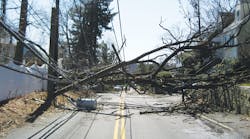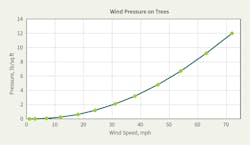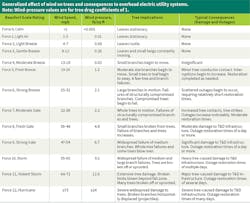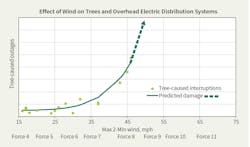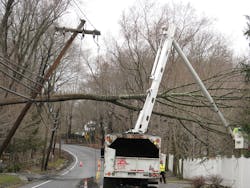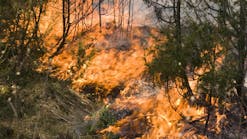Electric utilities operate thousands of miles of overhead power lines and typically maintain hundreds of thousands of trees or more. Tree risk assessments conducted by utilities consider the risk presented by individual trees, as well as overall risk from a large population of trees.
Trees in the height reduction and edge zones of the utility forest are maintained by line-clearance pruning. In addition, many more trees typically are in the strike zone—beyond where routine inspections and preventive line-clearance maintenance work is performed—which are capable of impacting utility infrastructure (also known as targets). For these reasons, utilities must consider the risk posed by entire populations of trees as well as individual trees. This means utility arborists typically have a broader perspective when applying tree-risk assessment than do commercial arborists working on individual client properties. Like utility arborists, municipal arborists have reason to consider both the performance of individual trees on loading events and the event’s broader impact on the urban forest.
While the likelihood of an individual tree striking a utility target may be very low, the composite exposure of the power system to tree strikes can be significant. If 99.99% of trees within a utility forest of 100,000 trees survive a windstorm event, 10 will fail, with potentially significant consequences. Considering many utilities systems are exposed to hundreds of thousands or millions of trees, it is clear windstorms can and do result in major events requiring extensive outage response, restoration and repair work.
Wind Loading On Trees
Trees fail when the forces they are exposed to overwhelm their strength to remain upright. The same can be said of branches; branch failures occur when the loads being applied exceed their ability to resist. The force being applied can either be static or dynamic. Static loading as a result of heavy, wet snow or ice applies constant force. Dynamic loading occurs as wind applies pressure to leaves, branches, stems and whole crowns. Variability in wind direction and speed as well as the active response of trees to wind pressure can result in large and rapid changes in the force experienced by the trees.
Four factors influence the dynamic force of wind on trees:
- Speed (velocity) of wind
- Variability in direction and speed (acceleration) of wind
- Mass of wind (air density, precipitation and even debris)
- Resistance and drag of tree to wind.
The combination and significance of each of these factors define the characteristics and destructive potential of a windstorm. As a result, the impact of windstorms on overhead power systems vary by storm and tree attributes.
Trees fail when wind loading exceeds a tree component’s capacity to withstand the mechanical load. Factors such as exposure, tree form, wood strength, structural defects, topography, soils and precipitation all can interact to affect the structural stability of individual trees during wind events. Each factor can vary across a utility’s service territory. The same variability can be said of the power system’s exposure to a storm event—being localized or widespread.
It is important to recognize changes in the profile of a tree as wind speed and loading increases. Leaves and branches are deflected, reducing and streamlining the canopy. Flexing of branches and stems decrease peak loads. As a result, the sail area presented to the wind varies by species and time of year. It may be reduced by more than 50% as wind speeds increase.
While recognizing variability in the vulnerability of individual trees to the force of wind, it is possible to characterize the pressure of wind exerted at the midpoint of a tree’s canopy. The curve resulting from a plot of pressure exerted vs. wind speed demonstrates a significant increase in the pressure of wind on a tree with increasing wind velocity. The wind pressure data used to plot such a pressure curve demonstrates three orders of magnitude (0.01 lb/sq ft to 10 lb/sq ft) increase across a range of winds to which trees and overhead utility lines are exposed. Given this large, rapid change in pressure being applied to trees as wind speed increases, it is no surprise tree-related damage dramatically increases at higher wind speeds.
Beaufort Wind Force Scale Adaptation
The Beaufort Wind Force Scale is an observational scale, first developed as a means of characterizing the effect of wind on water as related to sailing vessels. It since has been adapted to describe the effects of wind on landscapes and trees. The Beaufort Wind Scale has proven useful in estimates based on effects of wind over large areas and in describing the effects of wind velocities on objects.
There is a high degree of variability between windstorms and the associated consequences of windstorms influenced by factors related to the tree, site and utility target exposed. The amount of tree-related damage to overhead utility systems also can vary by the condition of the infrastructure itself as well as by vegetation management practices. However, it is possible to describe generally the effect of wind on trees and utility systems. The data shown in the table is an adaptation of the Beaufort Wind Force Scale, which describes in general terms the expected effect of wind on trees in the utility forest as well as the consequences of tree contacts and strikes on overhead electric T&D systems.
Impact Of Wind
Overhead electric utility systems have a high degree of exposure to tree-conductor contacts and tree strikes where overhead lines are in proximity to trees, such as in natural and urban forests as well as other tree-filled landscapes.
The consequences of tree contacts are direct, such as damage to infrastructure, and indirect, such as the loss of service to customers. It is not uncommon for an overhead power system to be exposed to many hundreds of thousands or millions of trees. As a result, windstorms associated with very low likelihood of failure rates for individual trees can result in major outage events. Windstorms with the addition of driving rain or ice accumulation can increase the force being applied, tree drag and tree component failure. These factors increase the amount of damage to overhead power systems, resulting in more interruptions and longer outages to customers.
When looking at how windstorms—16 events over a span of two years—impacted a large investor-owned utility located in the Mid-Atlantic region of the U.S., it was consistent with the industry’s experience. There was a nonlinear relationship between wind speed and outages. While tree-caused outages occurred sometimes at relatively low wind speeds, the increase was sharp as winds reached and exceeded Force 7.
At lower wind speeds, outages commonly are associated with tree-initiated electrical short-circuit faults that occur when a failed branch provides a pathway between areas of unequal electrical potential. These faults typically are interrupted by the overcurrent protection system (fuses, reclosers and breakers) without serious damage to utility infrastructure. As wind speed increases, line strikes by larger branches and whole trees result in increasingly severe damage to the overhead power system.
Concluding Remarks
Some level of tree and tree part failures must be expected and accepted. Line strikes as a result of winds greater than moderate gale (Force 7) generally are beyond the control of utility arborists and foresters. As such, fresh gale, strong gale, storm, hurricane and tornado winds are considered force majeure, or acts of God, conditions that are, by definition, unavoidable. Utilities and urban forestry organizations should apply reasonable due diligence to reduce the potential for damage to their systems as a result of foreseeable tree failure, by implementing the latest best management practices (BMPs) for tree risk assessment and by educating customers and stakeholders on the risks related to unmanaged trees near power lines. Finally, further education is required to help stakeholders understand it is not possible to eliminate the risk to overhead utility lines from tree failures during adverse weather. There will always be residual risk.
